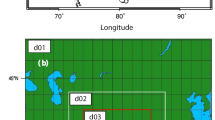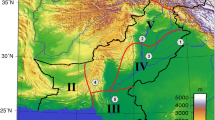Abstract
In the changing climate scenario, the changing heat wave frequency and magnitude have a direct impact on the agriculture, society, economic, and public health. Hence, development of easy and effective tools is essential for quantifying the heat wave incidences for better planning and management towards reducing the impacts of heat waves. In the present study, Climate Prediction Centre (CPC) global daily maximum temperature data along with the long-term normal data for the period 1979–2017 were used for quantification of heat wave conditions. Spatial and temporal sub-setting was carried out to restrict our study within the Indian region and March–July period, respectively. Based on heat wave criteria prescribed by the India Meteorological Department, different heat wave parameters, viz. frequency, magnitude, and extent, were estimated. A new approach, i.e. combined heat-wave index (CHI), was proposed to quantify the impact of heat wave in a profound manner. The efficacy of the overall method of assessing the impact of heat wave had increased by using this new approach. It was found that Rajasthan, Punjab Haryana, and Madhya Pradesh experienced high frequency as well as magnitude of heat wave, while it was lower in north-east, peninsular, and parts of northern India during our study period. The trend analysis for the heat wave parameters along with CHI was carried out over the Indian region during the last 39 years. The increasing trends were found over Rajasthan, Haryana, Punjab, East Madhya Pradesh, and Orissa, while places like Uttar Pradesh, Bihar, Chhattisgarh, Telangana, and Andhra Pradesh showed decreasing trend over the last 39 years. Peninsular and north-east India showed almost no trend regarding heat wave. Further, the month with the maximum contribution towards the seasonal heat wave and its deviation was also estimated. It was observed that the month of May was contributing most over parts of north-western and central India, while it was June in Punjab, Haryana, and western Rajasthan. Hence, the present methodology may be adopted for better planning and management of heat waves.










Similar content being viewed by others
References
Christidis N, Jones GS, Stott PA (2015) Dramatically increasing chance of extremely hot summers since the 2003 European heatwave. Nat Clim Chang 5:46–50
Coffel ED, Horton RM, Ade S (2018) Temperature and humidity based projections of a rapid rise in global heat stress exposure during the 21st century. Environ Res Lett 13:014001
Dash SK, Mamgain A (2011) Changes in the frequency of different categories of temperature extremes in India. J Appl Metoro Clim 50(9):1842–1858
Davis R, McGregor G, Enfield K (2016) Humidity: a review and primer on atmospheric moisture and human health. Environ Res 144:106–116. https://doi.org/10.1016/j.envres.2015.10.014
De US, Mukhopadhyay RK (1998) Severe heat wave over Indian subcontinent in 1998 in a perspective of global Climate. Curr Sci 75:1308–1311
Dunne JP, Stouffer RJ, John JG (2013) Reductions in labour capacity from heat stress under climate warming. Nat Clim Chang 3:563–566
Field CB, Barros V, Stocker TF, Qin D, Dokken DJ, Ebi KL, Mastrandrea MD, Mach KJ, Plattner GK, Allen SK, Tignor M and Midgley PM (2012) Managing the risks of extreme events and disasters to advance climate change adaptation, Cambridge University Press, Cambridge, UK, and New York, NY, USA, 2012,582p
Fischer E, Knutti R (2013) Robust projections of combined humidity and temperature extremes. Nat Clim Chang 3:126–130. https://doi.org/10.1038/nclimate1682
Hass AL, Ellis KN, Mason LR, Hathaway JM, Howe DA (2016) Heat and humidity in the city: neighbourhood heat index variability in a mid-sized city in the South-eastern United States. Int J Environ Res Public Health 13(1):117
Huang C, Barnett AG, Wang X, Vaneckova P, Fitzgerald G, Tong S (2011) Projecting future heat-related mortality under climate change scenarios: a systematic review. Environ Health Perspect 119:1681–1690
IPCC (2012) Managing the risks of extreme events and disasters to advance climate change adaptation. Field CB, Barros V, Stocker TF, Qin D, Dokken DJ, Ebi KL, Mastrandrea MD, Mach KJ, Plattner GK, Allen SK, Tignor M and Midgley PM (Eds.). Cambridge University Press, ENGLAND, 582 pp. Available from June 2012. https://www.ipcc.ch/report/
Jaswal AK, Rao PCS, Singh V (2015) Climatology and trends of summer high temperature days in India during 1969–2013. J Earth Syst Sci 124:1–15. https://doi.org/10.1007/s12040-014-0535-8
Johnson RG, Kandeh M, Jalloh A, Nelson GC, Thomas TS (2015) Sierra L 2015. In: Jalloh A, Nelson GC, Thomas TS, Zougmoré B, Roy-Macauley H (eds) West African agriculture and climate change: a comprehensive analysis. International Food Policy Research Institute, Washington
Mahdi SS, Dhekale B (2016) Long term climatology and trends of heat and cold waves over southern Bihar, India. J Earth Syst Sci 125(8). https://doi.org/10.1007/s12040-016-0762-2
Mandal R, Joseph S, Sahai AK, Phani R, Dey A, Chattopadhyay R, Pattanail DR (2019) Real time extended range prediction of heat waves over India. Sci Rep 9:9008
Matthews TKR, Wilby RL, Murphy C (2017) Communicating the deadly consequences of global warming for human heat stress Proc. Nat Acad Sci 114:3861–3866
Meehl GA, Tebaldi C, Walton G, Easterling D, Mc. Daniel L (2009) Relative increase of record high maximum temperatures compared to record low minimum temperatures in the U.S. Geophys Res Lett 36:110–125
Mishra V, Ganguly AR, Nijssen B, Lettenmaier DP (2015) Changes in observed climate extremes in global urban areas Environ. Res Lett 10:024005
Mishra V, Mukherjee S, Kumar R, Stone DA (2017) Heat wave exposure in India in current, 1.5°C, and 2.0° C worlds. Environ Res Lett 12:124012
Mukherjee S, Mishra VA (2018) Sixfold rise in concurrent day and night-time heatwaves in India under 2°C warming. Sci Rep 8:16922
National Weather Service (2014) Heat: a major killer; www.nws.noaa.gov/os/heat/index.shtml.
Oldenborgh GJ, Philip S, Kew S, Weele M, Uhe P, Otto F, Singh R, Pai I, Cullen H and AchutaRao K (2018) Extreme heat in India and anthropogenic climate change. Nat Hazards Earth Syst Sci 18:365–381. https://doi.org/10.5194/nhess183652018
Pai DS, Nair SA, Ramanathan AN (2013a) Long term climatology and trends of heat waves over India during the recent 50 years 1961–2010. Mausam 64:585–604
Pai DS, Smitha A, Ramanathan AN (2013b) Long term climatology and trends of heat waves over India during the recent 50 years (1961–2010). Mausam 64:585–604
Ratnam JV, Behara SK, Ratna SH, Rajeevan M, Yamgata T (2016) Anatomy of Indian heatwaves. Sci Rep 6:24395. https://doi.org/10.1038/srep24395
Rohini P, Rajeevan M, Srivastava AK (2016) On the variability and increasing trends of heat waves over India. Sci Rep 6:26153. https://doi.org/10.1038/srep26153
Singh A, Patwardhan A (2012) Spatio-temporal distribution of extreme weather events in India. APCBEE Procedia 1:258–262. https://doi.org/10.1016/j.apcbee.2012.03.042
Smith KR, Woodward A, Campbell-Lendrum D, Chadee DD, Honda Y, Liu Q, Olwoch JM, Revich B and Sauerborn R (2014) Human health: impacts, adaptation, and co-benefits Climate.
Stocker TF, Qin D, Plattner GK, Tignor M, Allen SK, Boschung J, Nauels A, Xia Y, Bex B, Midgley BM, Climate Change (2013) The Physical Science Basis. Cambridge University Press, London, pp 161–162
Sun Y, Zhang X, Zwiers FW, Song L, Wan H, Hu T, Yin H, Ren G (2014) Rapid increase in the risk of extreme summer heat in Eastern China. Nat Clim Chang 4:1082–1085
Thamo T, Addai D, Pannell DJ, Robertson MJ, Thomas DT, Young JM (2017) Climate change impacts and farm-level adaptation: economic analysis of a mixed cropping–livestock system. Agric Syst 150:99–108
White B (2010) Climate change: impacts, adaptation, and vulnerability. Cambridge University Press, London
Zhang R, Chen ZY, Ou CQ, Zhuang Y (2017a) Trends of heat waves and cold spells over 1951–2015 in Guangzhou, China. Atmosphere 8:37
Zhang Y, Yu C, Bao J, Li X (2017b) Impact of temperature on mortality in Hubei, China: A multi-county time series analysis. Sci Rep 7:45093. https://doi.org/10.1038/srep45093
Acknowledgments
We express our sincere thanks to Shri. Santanu Chowdhury, Director, National Remote Sensing Centre (NRSC), for his constant encouragement and suggestions. Guidance received from Dr. C. S. Jha (CGM, RCs) and Dr. D. Dutta (GM, RRSC-East) is duly acknowledged. We are also thankful to Climatic Prediction Center (CPC), NOAA, for providing gridded temperature data and India Meteorological Department (IMD) for providing the heat wave criteria. The authors are grateful to those anonymous reviewers for their constructive suggestions.
Author information
Authors and Affiliations
Corresponding author
Additional information
Publisher’s note
Springer Nature remains neutral with regard to jurisdictional claims in published maps and institutional affiliations.
Rights and permissions
About this article
Cite this article
Das, P.K., Podder, U., Das, R. et al. Quantification of heat wave occurrences over the Indian region using long-term (1979–2017) daily gridded (0.5° × 0.5°) temperature data—a combined heat wave index approach. Theor Appl Climatol 142, 497–511 (2020). https://doi.org/10.1007/s00704-020-03329-7
Received:
Accepted:
Published:
Issue Date:
DOI: https://doi.org/10.1007/s00704-020-03329-7




